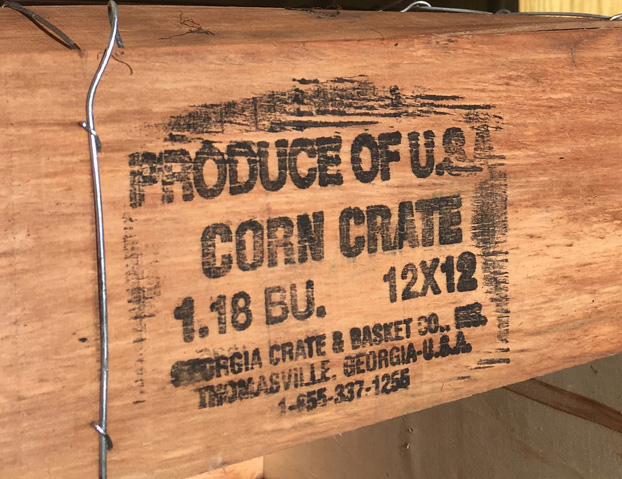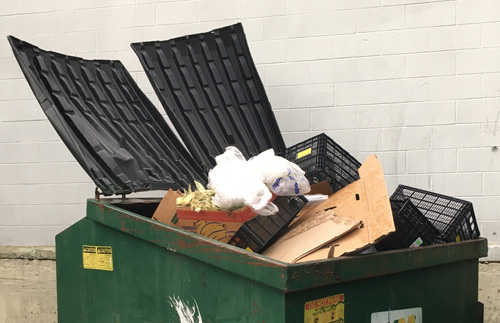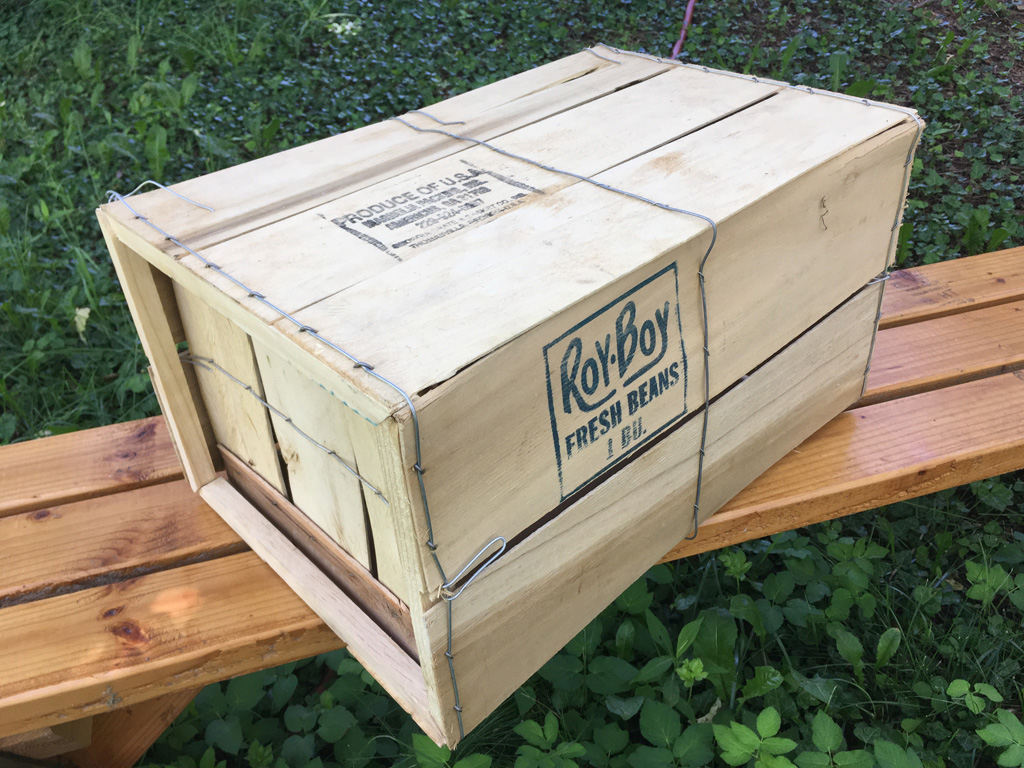The material culture of the modern world includes objects that will only be experienced by those in very specific professions. An example is the wirebound crate — familiar primarily to farm workers and backroom grocery clerks, it is a lingering but rapidly disappearing throwback to a simpler time, when sustainable packaging was the default.
But before we visit the charismatic technology depicted above, let us consider its modern replacement, seen below: the waxed produce shipping box. Most of us who stay on the retail side of our favorite store will never encounter these large, perforated, waterproofed shipping boxes, as their job is done once they have conducted a single bushel of bulk produce to the rear door of our favorite grocery. Made of heavily waxed cardboard to resist the moisture of their contents, they are not welcome in the cardboard recycling bin — although I casually assumed in another article that waxed packaging materials are recyclable. Whether they are or not, almost all of these boxes make their way directly to the dumpster, sometimes filled with spoiled produce that was pulled off the shelves the day before. In fact, by federal law they are effectively not reusable either.

Enter the much more genteel version of the produce box, a holdover from times past: the wirebound crate. An ungainly and awkward thing by comparison to the sleek wax carton, it possesses a remarkable, effective, yet simple design, comes in surprisingly many varieties, and is completely environmentally benign in its disposal.

Slats of a thin veneer of wood, sometimes roughly cut and often of marginal quality, are cleverly bound together with steel baling wire and staples, to create a wonderfully retro crate that would feel at home in a Civil War commissary. Wood veneer stands up well to the moisture of fresh produce, and ventilation is achieved by gaps between the slats. The width of the gaps varies by design, depending on the amount of ventilation required for the specific type of produce to be carried. There are bean crates, corn crates, celery crates, and several other types. Corn crates have wide gaps at the sides, and none at the ends. Bean crates have narrow gaps on the sides and the ends (or sometimes, holes punched in the ends). There are odd variations in their size, such as 0.99 bushel and 1.18 bushel, the significance of which is not clear but probably has an explanation steeped in custom and tradition. Some are labelled with an inked rubber stamp, others are pyrographically branded with a hot iron. Once filled, they are closed with a quick bend of three loops of the same wire that holds the crate together. Predictably, they are more expensive to buy than the much more common wax boxes — but not by that much. According to prices published online in June 2021 for bean crates at a produce packaging distributor, a wirebound bean crate goes for about $2.88 while the wax version of the same capacity goes for $2.22.
It is hard to believe that this venerable, simple technology continues to exist in the face of its modern competition. When I was a child, often my father and I would sit in the car while my mother was shopping at our local small-town neighborhood supermarket (another thing that has virtually disappeared today). An older brother was a teenage employee at this store, and would alert my father whenever they were throwing out something we could use on the farm. We were, after all, a frugal family. Crates and boxes were the usual item, and they would be piled up next to the dumpster, for anyone to take, in the teenage help’s hopes that they would disappear before they had to be broken down. Dad often took some for various uses, and among them often was one or two wirebound crates. He would typically use them on trash day — in those days, there were no standard rubberized containers used for garbage pickup at the curb, nor were plastic garbage bags all that well accepted yet — so everyone either had to use their own garbage can, or else package their trash in a disposable box of some kind that was strong enough to withstand the rain, raccoons, and wandering neighborhood dogs, but small enough not to break the trash collector’s back. To my Dad’s judgment, these occasional cast-off wirebound crates fit the bill better than anything else.


Produce distribution waste
The degree of produce spoilage and waste that takes place in the average supermarket is a topic for another day. There is far less public awareness of the tremendous waste stream at the back end, that results from simply getting the produce to the store. The wax produce box pictured previously is made of 1.2 kilograms of waxed cardboard, and U.S. federal law effectively prohibits its reuse — due in part to the strict sanitizing requirement for reuse, under the FDA’s Food Safety Modernization Act (FSMA) Produce Safety Rule (PSR).
So it seems that, by current law, produce crates are destined to either be sanitizable, or disposable. So, what are the options?
Plastic crates do exist, as seen below — and are clearly sanitizable. They are a very common companion of the wax box in U.S. produce shipments today. Yet, in my experience (with the cooperation of my friendly local produce market) they also make their way into the trash dumpster, without exception. This pile of black plastic crates was typical of the average contents of a single waste dumpster on my research visits to the produce market. No distributor wants them back. Like it or not, the distribution system is not primed for collection, sanitization and reuse — product distribution today is a one-way street. Discarding is much more convenient, and is happily accommodated by the commercial waste management services who frankly don’t have much reason to care about potential recyclables being placed in the trash dumpster, as long as they can be buried in the landfill – a service for which they make a profit.

These crates appear to be manufactured by various companies in Mexico — probably because that’s where much of the produce in the U.S. comes from. These companies have vaguely ironic names such as Eco-Pack, Wast’n-Value, and FrescoPack. In a seeming acknowledgement of their products’ fate, they are not marked for recycling. If not for the upbeat names of their companies, I’d say at least they’re being up front about it. Perhaps it attests to how far we’ve come down the path of disposable product packaging that I can’t imagine how a distribution network that collects these perfectly usable crates, sanitizes them, and ships them back across the border for reuse could possibly exist, except by legislation of a sort that no one seems interested in proposing, let alone implementing. Even in the face of an increasingly obvious plastic pollution crisis, no one with a stake in the retail trade that brings it about has an appetite to be bothered with such a thing.

The wax box is king
If the law prohibits produce packaging from being reused without being sanitized, and the distribution system is going to cause them to be discarded even if they can be sanitized, then we are left with the question: Is the wax box the best solution? In the landfill, the wax box does degrade, but only slowly. And wax contains petroleum-derived paraffin, perpetuating demand for petroleum resources that are probably better off remaining in the ground. Wax boxes are also a fire hazard wherever they are stored, adding to the urgency of getting rid of them. (If you’re looking for a substitute for charcoal lighter fluid to get a bonfire or a pile of wet brush going, try lighting part of a wax produce box underneath it — only part — and you’ll know what I mean). If not discarded immediately, they quickly build up at loading docks. If their presence isn’t accounted for in the price of fire insurance premiums, it should be.
Who still makes wirebound crates?
Today it seems that only a handful of companies still make wirebound crates. Our culture has long since accepted and doubled down on the unfettered, unquestioning and gratuitous use of plastic for single-use items, a trend that decimated companies like these, that had made more sustainable but perhaps less convenient alternatives for generations. But based on the small sample of crates I’ve collected (again from my friendly local produce market), at least a couple still exist. Both Elberta Crate and Box and Georgia Crate & Basket Company are located in Georgia and serve producers nationwide.
It’s very doubtful to me that these companies will ever find themselves in direct competition with wirebound crate manufacturers other than themselves. I would speculate that entering the produce packaging market is much simpler as a wax box manufacturer or a plastic injection molder. Box and molding equipment is available new from a wide variety of makers, and there is a robust service industry to support it when something breaks down. But making wirebound crates requires a very different set of specialized equipment that likely isn’t being made anymore — nor are the people who know how to operate and fix it. It’s an example of another concept I’ll be writing about, the family business succession problem — the tendency for legacy, often-beloved local businesses to become literally irreplaceable, because they could never be remotely profitable if they had to rebuild themselves from scratch in the same form and location. Think of things like the venerable neighborhood thrift store, the iconic old-fashioned-hardware store, or the century-old mom-and-pop locksmith shop, that has continued to exist as an inexplicable anachronism in a neighborhood that has long since become upscale, gentrified and unaffordable. It happens when Mom and Pop just happen to own their building free and clear, and their shop makes enough to get by, and they aren’t going anywhere. When they decide to retire, they’ll sell out the real estate, and they may make a mint — good for them! But there can never be something like a thrift store or locksmith shop there, ever again. No such low-key business could ever make enough money to afford the rent or mortgage, or sometimes even the property taxes, on such prime real estate.
For similar reasons, these box and crate manufacturers may be a rare and dying breed. However, their age-old product makes us look in a direction that may be exactly where our plastic-choked planet needs to orient itself toward. If we’re going to routinely send used produce boxes to the landfill, even when they’re good for many more uses, I’d rather it be produce boxes made of natural material that will someday decompose, and leaving no chemical or petroleum residues to contribute to the toxic leachates that will bleed from our landfills for generations.
And they have alternative uses as well. As a planter, I’m not sure how well it will last the season, but so far so good. Diverting waste by repurposing it is not as sustainable as reusing it for the same purpose, but given that the predominance of products available for container gardening are made of plastic, anything that might wean us away from it is a worthy experiment indeed.




2 Comments
Pingback:
Jon
My family owns and runs a “Farmers Market” in Southwestern Michigan. It was established in 1960, and thrives to this day. I am currently a supervisor there. I have a side-gig where I buy and resell on Ebay. I’m also a crafter, and moreover, a hoarder of items I determine to be of use for such that I can sell.
As of late, I have been collecting wire-bound produce crates with the intent of upcycling them. They inspire many different sorts of creations, both intact, or broken down into usable sections.
I found your article to be a lone and fascinating homage to the overlooked, hard-suffering, and humble crate.
I will bring this to the attention of my ninety-two year old father, as I believe it will be an enlightenment to him as well.
Thank you,
Jon Shelton
Supervisor at Shelton’s Farm Market
Niles, Michigan